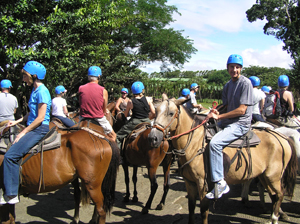|

Overcoming Four Greatest Obstacles to Following
the McDougall Diet
Last
week we returned from our biannual adventure trip to
Costa Rica. I spent 7 relaxing days with 100 people
from various part of the United States and Canada. This afforded
me many hours for casual conversations with travelers
who were at various stages of dietary change. I heard
about medical miracles, such as weight losses of 60
pounds and more, relief of crippling arthritis, chest
pains, and diarrhea, and stopping bagsful of expensive
medications. Mixed up in these chats about healing were
pleas for even greater success and more help. People
told me of facing difficulties like:
“I’m
incurably ill, but I can’t change my diet, so that is
why your program won’t work for me.”
“For a
whole bunch of reasons I like the fact that I am a
vegan, but I never seem to be satisfied.”
“I
have lost 70 pounds, but I have 60 more to lose. I’ve
been at this plateau for 6 months.”
“I
did well the first 6 months after leaving your 10-day
program; however over the last year I have lost all the
health I had gained, and gained all the weight I had
lost.”
Let me
offer some painless and simple solutions for these
common obstacles.
Obstacle #1: Change Is Difficult
Cindy
is a 48–year-old woman from Oklahoma. She was diagnosed
with colon cancer 10 years ago; follow-up treatments
included surgery, radiation, and chemotherapy. Since
then she has suffered from debilitating, daylong
diarrhea. She and her husband were invited by a friend
to attend the McDougall Costa Rica Adventure. After
hearing about the exclusively vegetarian diet served on
this trip, she protested, saying all those high-fiber
vegetables would aggravate her bowels and cause her to
spend the entire trip in the bathroom. She soon
discovered the opposite.
 After
the first day her watery diarrhea had stopped and by day
three she was having two formed stools a day. This rapid
improvement was no surprise to me. In 1974 Dr.
Andersson (Nutr
Metab.17:102)
published research showing these benefits—people with
damaged small intestines (called an ileopathy) went from
20 watery stools a day to two or three formed movements
within 72 hours of changing to a low-fat diet. After
the first day her watery diarrhea had stopped and by day
three she was having two formed stools a day. This rapid
improvement was no surprise to me. In 1974 Dr.
Andersson (Nutr
Metab.17:102)
published research showing these benefits—people with
damaged small intestines (called an ileopathy) went from
20 watery stools a day to two or three formed movements
within 72 hours of changing to a low-fat diet.
Fats
and oils cause the liver to produce large amounts of
bile acids. Unfortunately, Cindy’s small bowel, damaged
by radiation treatments given 10 years ago, could not
reabsorb these bile acids, so they passed freely into
her large intestine where they caused severe irritation
and diarrhea. Not by Cindy’s own choosing, the low-fat,
plant-foods served in our Costa Rican resort’s
restaurant ended 10 years of needless suffering.
Change
is difficult. The purpose of our residential programs
(at home and abroad) is to create environments that
facilitate change. But you can create a similar
situation at home for free. A detailed description of
my 10-day
program is provided at no cost on my web site .
People are always amazed by how many of their incurable
ills are fixed after only a few days of eating right.
They are equally surprised by how forcefully their
problems return when they slide back into their old
ways. My guess is Cindy will only have to experience
McDougall’s revenge a very few times before she becomes
permanently committed to eating perfectly.
Obstacle #2: McDougall Is Not about Vegetables
Betty
is a trim, physically active, 40-year-old woman from
California who has been trying to follow the McDougall
Diet for more than a year. She has found our plan
impossible to stick with; feeling hungry, fatigued, and
frustrated. That changed for her after my orientation
lecture, “The McDougall Program for Maximum Weight loss”
just a few days ago in Costa Rica.
I
explained to the audience that people often believe that
the McDougall Diet is a “vegetable-based diet,” and as a
result, they are left wanting. Green and yellow
vegetables, such as broccoli, cauliflower, peapods,
green peppers, and lettuce, are too low in calories to
provide satisfaction. The primary purpose of eating is
to obtain life-giving energy. This is accomplished
safely only by whole plant foods plentiful in
carbohydrates. These special plant foods are known as
starches. Because of their natural satisfying
properties people refer to potatoes, rice, pasta, beans,
and corn as “comfort foods.” In addition to “clean and
efficient energy,” starches provide an abundance of
other nutrients, such as proteins, essential fats,
vitamins, and minerals. Single starches, such as
potatoes and sweet potatoes, are “complete foods” and
can easily meet all of our nutritional needs.
 People
get a glazed look over their faces, and some dismiss me
as crazy, when I tell them I recommend a starch-based
diet. They think of starch as something used in the
laundry to stiffen shirts. Starch brings back memories
of pasty bland-tasting goop, and white, airy Wonder
Bread. Most disturbing is that nearly everyone believes
starches are fatting. Fortunately, common knowledge is
completely wrong and the proof is before your own eyes. People
get a glazed look over their faces, and some dismiss me
as crazy, when I tell them I recommend a starch-based
diet. They think of starch as something used in the
laundry to stiffen shirts. Starch brings back memories
of pasty bland-tasting goop, and white, airy Wonder
Bread. Most disturbing is that nearly everyone believes
starches are fatting. Fortunately, common knowledge is
completely wrong and the proof is before your own eyes.
Ancient pictures and writings show us that all major
populations of people have lived on diets based on
starches: potatoes in the Andes of South America, corn
in Central America, wheat in Central Europe, and rice in
Asia. Even today 60% of people worldwide follow a
starch-based meal plan—and by no coincidence these same
people are trim, healthy, active, and youthful. When
they abandon starch for meat and dairy they develop
obesity, diabetes, cancer and heart disease. It’s
the starch folks! And with this realization you
will be set free to better enjoy life.
The
proper scientific term for foods containing an abundance
of complex carbohydrates is starch. During the growing
season, green leaves collect energy from the sun and
synthesize sugars that are converted into tiny starch
granules, which are eventually stored in the plant parts
for their own use later in the year. These same
stored-carbohydrates also provide us with ideal sources
of food for all year long. People are “starch-eaters.”
(Like cats are “meat-eaters” and giant anteaters are
“ant-eaters.”) Violate your nature and the price of poor
health will be paid.
Betty
ran every day in Costa Rica with the energy of an
Olympic athlete. She left her meals comfortably full
and did not experience hunger for several hours after
eating. She even told me of a new sense of calm that had
settled over her. By the simple mind change of putting
starch at the center of her diet she has gained control
of her life. The last thought she shared with me was,
“It all makes sense now.”
Obstacle #3: Failure to Appreciate the Body’s Efficiency
Robert, a 50-year-old doctor from California, lost 70
pounds on the McDougall diet during the first year with
the program. His debilitating back pains almost
disappeared, as did his generalized arthritis. However,
over the last 6 months he has lost nothing more, with 60
more pounds still to shed. “It is not fair,” he said, “I
eat better than ever before, and I am stuck at this
plateau.”
For
the past 3 decades his body had adapted nicely to
carrying around an extra 130 pounds with surprising
little complaint. Compared to before, his highly
efficient body is now very pleased to be just carrying around an extra 60 pounds. But that is still
only possible because his current eating and exercise
habits are able to support this extra body fat. So what
is this man to do?
 Robert, and others stuck at similar roadblocks, must
make even more changes in order to set a new body weight
and higher level of health. And that means a stricter
diet and exercise program—because obviously the one that
he is currently following has allowed him to remain at
an undesired plateau. Paying closer attention to the
details of the McDougall program will start people back
on the losing track. Robert, and others stuck at similar roadblocks, must
make even more changes in order to set a new body weight
and higher level of health. And that means a stricter
diet and exercise program—because obviously the one that
he is currently following has allowed him to remain at
an undesired plateau. Paying closer attention to the
details of the McDougall program will start people back
on the losing track.
Give
up the nuts, seeds, cold-pressed olive oil, dried
fruits, refined flours, and all the other rich treats
you have been pampering yourself with since your gave up
meat and dairy. Right, they are all vegan (not from an
animal), and even more holy, they are mostly “raw.” But
they are still “calorie bombs,” which are guaranteed to
stop weight loss and cause fat gain.
Eating
out in restaurants is the second most common way people
consume too many calories, even when they make efforts
to eat vegan. Plan on it—these commercial food outlets
are going to try to please you at every meal by
enhancing the flavor of your dishes with added sugars,
refined flours, and vegetable fats. The best solution
is to fix all your own meals at home and pack your
lunches for when you are away. Carry a cooler of food
when you travel long distances. Short of following this
serious recommendation, find restaurants that will serve
you basic foodstuffs, like whole beans, steamed rice,
baked potatoes, green salads, and plain fruits.
Eat
simpler for better health and easier weight loss. At
home, plan meals of cooked whole grains or oil-free hash
browns for breakfast and pack your lunch with leftovers.
For dinner, think “two choice combinations,” like sweet
potatoes and broccoli; rice and green beans; or beans
with a few plain condiments. Simple, monotonous meal
plans facilitate success.
Finally, move your “stuck body” off of its present
comfort setting by exercising more. Exercise burns
calories, occupies time you might spend eating, relieves
anxiety and depression, and makes the appetite more
appropriate for your caloric needs. Robert is more than
half way to his weight goal, and he will succeed. After
all, his record of success shows he is capable of change
and the rewards he has found so far make him greedy for
even more improvements.
Obstacle #4: No One Responsible Is Fixing Your Food
Mark
is 61-year-old successful businessman from Arizona. My
guess is his wealth amounts to tens of millions of
dollars. His wife is a busy businesswoman. These two
people seem to control everything in their lives, except
for their food. But, everyone must eat, and satisfying
meals do not magically appear at the doorstep.
Drive-through windows at McDonald’s and Taco Bell are as
close as you can come to this fantasy. Unfortunately,
these fast foods are health-destroyers. So how do busy
people—and those who hate to cook—get fed safely?
I
asked Mark, “Do you cut your own lawn?” No, he has a
gardener. “Does your wife clean the house?” No, they
have weekly maid service. “So, Mark, why don’t you have
someone prepare your foods? You certainly can afford
it. The cost of doing nothing could be as expensive as
a $100,00 heart bypass operation. Now does that make
financial sense to a businessperson like yourself?”
 Cooks
can be found with a little effort. Ask around. Check
with your local vegetarian society or your local natural
foods store. Put an ad on their bulletin board or in the
local newspaper. Hire a chef through the web site
www.hireachef.com. Domestic help can make your meals
outside of your home and deliver them weekly. Or this
person can come to your house one day a week in order to
prepare some of your favorites. Talk to a catering
service in your town. Many caterers will use your own
recipes (from Mary’s books and the web site) to prepare
your meals for the week. Cooks
can be found with a little effort. Ask around. Check
with your local vegetarian society or your local natural
foods store. Put an ad on their bulletin board or in the
local newspaper. Hire a chef through the web site
www.hireachef.com. Domestic help can make your meals
outside of your home and deliver them weekly. Or this
person can come to your house one day a week in order to
prepare some of your favorites. Talk to a catering
service in your town. Many caterers will use your own
recipes (from Mary’s books and the web site) to prepare
your meals for the week.
With
some relatively inexpensive outside help, you now have a
refrigerator filled with delicious sauces and soups.
After a hard day’s work all you have to do is bring home
a loaf of store-bought whole grain bread, boil some
rice, or microwave a potato. To these basic starches
add your pre-prepared soups or sauces. Bagged, washed
salad greens and a low-fat salad dressing purchased in
the market make a colorful addition. If hiring help is
out of the question, then do it yourself. Take one day
each week to prepare the basic sauces and soups for your
meals.
Our
Costa Rica Adventures Attract the Nicest People
People, who travel with us, and those who come to our
Santa Rosa programs, always amaze me. I find myself
saying, “I don’t know how we attract so many
interesting, intelligent, and pleasant people.”
Typically, our clients are well educated and successful.
They also demand the best life can offer. Soon after
they discover the importance of food, they make efforts
to switch to a starch-centered diet. That’s where the
McDougall Programs and Trips help. My final words of
reassurance are: Our principles of diet and exercise are
simple and basic—no gimmicks. The Program always works.
But your success may require overcoming the common
obstacles I witnessed during our recent trip to Costa
Rica.
The
names of people have been changed, but the accounts are
real and from our July 2008 Costa Rica McDougall
Adventure Trip.
You
can find additional comments and add your own at my
discussion board under the heading, “Comments on the
latest newsletter and Star Mcdougaller. |